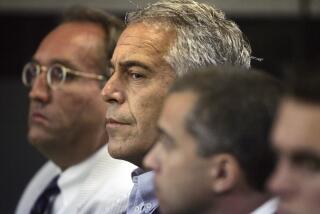FBI releases serial killer Israel Keyes’ interrogation tapes
- Share via
Officials now believe that an Alaskan serial killer claimed at least 11 victims across the United States over more than a decade of violence before his arrest and jailhouse suicide last year.
Yet only three of Israel Keyes’ victims have been identified, a number that hasn’t risen since the early days of a tricky investigation.
The revelation came as officials released a trove of interrogation videos with the serial killer this week as part of an ongoing investigation into Keyes’ career as a murderer, arsonist, bank robber and rapist, which he had confessed to interrogators only in fragments and allusions up to his death in December.
“He talked openly about some of the homicides, but much of what he said only hinted at the things he had done,” Special Agent Jolene Goeden said in a Tuesday news release. “So we are trying to get information out there about what he did tell us. We are letting the public know the types of cars he rented, towns he visited, campgrounds he frequented. Anything that might spur someone’s memory could help us.”
Keyes was arrested in Texas in March 2012 in the killing of Anchorage barista Samantha Koenig, 18.
Shortly before his arrest he had embarked on a crime spree in the southwestern U.S., which officials believe included the burning of a home in Aledo, Texas, the robbery of a bank in Azle, Texas, and a possible 11th slaying, which investigators disclosed for the first time this week.
“Although he denied it, investigators believe Keyes may be responsible for a homicide in Texas or a surrounding state during this time,” Deirdre Fike, chief agent in the FBI’s Alaska division, said in a Monday statement.
Officials believe Keyes’ other attacks included:
--A 1997 or 1998 sexual assault of a teenage girl along the Deschutes River in Oregon;
--A homicide between July and October, 2001, when Keyes lived in Neah Bay, Wash.;
--The killing of a couple in Washington between July 2001 to 2005;
--Two separate killings between 2005 and 2006, in which Keyes said at least one body was dumped in Crescent Lake in Washington;
--Abducting and killing a woman on the East Coast and burying her body in upstate New York on April 9, 2009;
--Robbing a bank in Tupper Lake, N.Y., on April 10, 2009;
--Killing Bill and Elaine Currier after abducting them from their home in Essex, Vt., on June 8, 2011;
--Abducting Samantha Koenig from the Anchorage coffee shop where she worked on Feb. 1, 2012, and then dumping her body in Matanuska Lake near Palmer, Alaska.
Keyes traveled extensively and officials believe he may have committed crimes during his other trips, which included ones to Canada, Mexico and Belize.
Officials also think he may have burglarized as many as 20 or 30 homes across the U.S. in addition to storing weapons and supply caches across the country to aid his killing trips. The FBI has published an interactive timeline of Keyes’ movements.
“At this point, this investigation is all about identifying the possible victims and bringing closure to their families,” FBI spokesman Eric Gonzalez told the Anchorage Daily News. “What makes this difficult is that, when it comes to the victims, it could be anyone. Male, female, young, old. They were more victims of opportunity than, say, fitting a certain victimology profile.”
Officials believe Keyes didn’t know his victims before killing them, and that their deaths were not well publicized in news outlets. They asked members of the public who might have information on Keyes to call (800) 225-5324.
The interrogation videos with Keyes are embedded below.
Israel Keyes interview, May 24, 2012:
Israel Keyes interview, May 29, 2012:
Israel Keyes interview, June 7, 2012:
Israel Keyes interview, July 26, 2012:
Israel Keyes interview, Nov. 29, 2012:
ALSO:
Bloomberg blasts ruling against NYPD’s stop-and-frisks
Defense seeks to show Bradley Manning was emotionally unstable
Tennessee judge, citing Jesus Christ, changes baby’s name from ‘Messiah’
More to Read
Sign up for Essential California
The most important California stories and recommendations in your inbox every morning.
You may occasionally receive promotional content from the Los Angeles Times.











